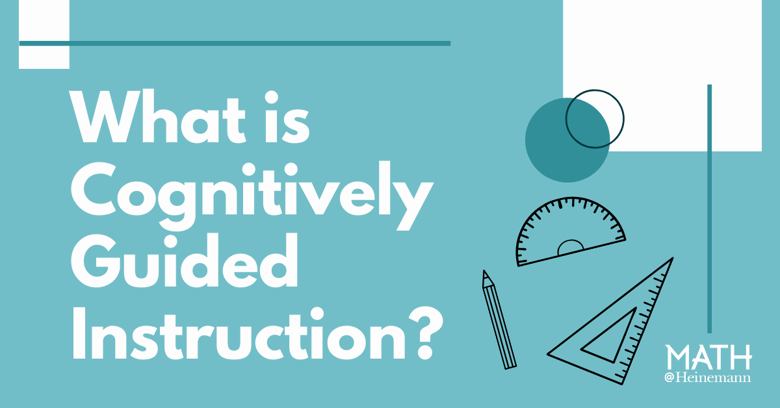 Hundreds of thousands of teachers across the US teach mathematics using Cognitively Guided Instruction (CGI). At Heinemann we often get the question from interested educators, What is CGI? Today we’ll give you an answer to help you decide if it might be right for your classroom.
Hundreds of thousands of teachers across the US teach mathematics using Cognitively Guided Instruction (CGI). At Heinemann we often get the question from interested educators, What is CGI? Today we’ll give you an answer to help you decide if it might be right for your classroom.
CGI’s classroom application is described in depth in the Heinemann titles Young Children’s Mathematics; Children’s Mathematics, Second Edition; and Extending Children’s Mathematics. Yet if you flipped through the books, you might notice there’s no heading in the introduction or the early chapters that says: What Is CGI? In fact, the term is never explicitly defined in any book of the Children’s Mathematics series. That’s because CGI isn’t a framework for instruction nor a math program nor again a style of classroom. CGI is a way of thinking about how you teach math and the actions you take as a result of that thinking.
Let’s turn to an analogy from a world many teachers feel a little more comfortable with than mathematics instruction: reading instruction. CGI is not analogous to, say, Reading Workshop. Instead it’s analogous to the decision to teach that way and the decision making you do as part of teaching with the workshop. If you decide that workshop is right for you and your readers, you are taking action on an internal belief that children deserve choice in their reading, the opportunity to read for authentic purposes, and time to practice independently with your mentoring coming in the form of conferences and small-group instruction. We could sum up those beliefs as a child-centered or constructivist approach to teaching reading that is responsive to each individual child’s thinking and needs.
The same is true for CGI in the mathematics curriculum. CGI simply means teaching that follows a child’s mathematical thinking—as opposed to forcing every child to solve problems the same way (often algorithmically). A CGI teacher presents problems designed to help children express their innate mathematical ideas then listens carefully to a child’s explanation of their problem-solving reasoning. “Children enter school with a great deal of informal or intuitive knowledge of mathematics that can serve as the basis for developing understanding of the mathematics of the primary school curriculum,” write Tom Carpenter, Elizabeth Fennema, Megan Loef Franke, Linda Levi, and Susan Empson, in Children’s Mathematics, Second Edition.
It’s just like a reading teacher listening carefully to a student during a reading conference. First they determine what a child’s strengths and needs are, then they follow with responsive instruction. With CGI, only after the teacher understands what mathematical strategies a child uses, does she ask What’s next for this child?
CGI depends upon student engagement with well-designed problems. What makes a good CGI problem? It needs to have relevance to students—just like classroom-library titles do for strong independent reading time. It also needs to start with a situation that children understand intuitively such as sharing five candy equally bars among four people. (Or worse, four candy bars among five people!) And it must help children make progress toward deeper understanding of the mathematical operation or idea they are building knowledge about so they can solve subsequent high-quality problems. “The critical consideration,” write Carpenter, Fennema, Franke, Levi, and Empson, “is that students are engaged in deciding how to solve problems using what makes sense to them.”
Here’s another way in which CGI and the workshop model share instructional DNA. They trust teachers to know their students. “We believe that you are in the best position,” write Empson and Levi in Extending Children’s Mathematics, “to decide the focus and timing of instruction.”
So Cognitively Guided Instruction is a way of viewing the interaction between teacher and student in the mathematics classroom and, thereby, provides a mental model for designing problems, assessing children’s thinking, and planning subsequent instruction. “Developing the capacity to listen to children’s thinking and act upon what you hear is an ongoing journey,” write Empson and Levi, “but the rewards can begin immediately when you take that first step—whether it is asking a child to solve a problem and listening with an open mind or engaging in solving problem in this book with a group of teachers and listening to each other.”
In the end, CGI boils down to a single idea: good, responsive teaching that takes children’s ideas seriously and helps students develop a more robust idea of the mathematical world around them.
 Follow us on Instagram @heinemannpub to stay up to date on the latest books, your favorite authors, and upcoming events!
Follow us on Instagram @heinemannpub to stay up to date on the latest books, your favorite authors, and upcoming events!




